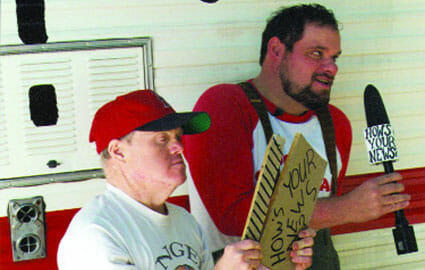
While serving as a counselor at Camp Jabberwocky, the nation’s oldest summer camp for mentally and developmentally disabled adults, novelist/director Arthur Bradford noticed that one of the campers’ favorite activities involved conducting “man-on-the-street” interviews. These quirky shorts, which were filmed and later turned into “news” segments by the camp staff, attained a measure of cult celebrity in film circles and it wasn’t long before two of Bradford’s friends, South Park creators Matt Stone and Trey Parker, offered to fund a feature-length film based on the same premise. So in the summer of 2001 Bradford hand-painted “How’s Your News?” on the side of an old RV, picked five of the more enthusiastic campers—some affected by cerebral palsy, others Down Syndrome—and set out on a cross-country journalistic experiment/odyssey.
The overwhelming majority of feedback from festival audiences and critics has lauded How’s Your News? for its “colossal humanity and infectious joy” (Montreal Gazette). I’d agree with that assessment, insofar as it shows great humanity to escort a group of disabled adults—who typically live out their days quarantined in special-ed classrooms, group homes and specialty camps—into the larger world. It shows great humanity to afford these people the unique opportunity of engaging the general public while enjoying a Kerouac-ian journey filled with moments of self-discovery. It’s a joy to see certain members of this band of crack reporters penetrate interviewees’ guarded exteriors and draw out some humorous and off-balance responses. But, sadly, not all the interviews here elicit such favorable results.
Larry, the reporter most woefully unequipped to conduct “man-on-the-street” interviews, suffers from a condition known as “spastic cerebral palsy,” which causes him to writhe about in his wheelchair, contorting his body and arms in jerky flailing movements. One of the filmmakers wheels Larry into a crowded public space near a subway entrance and leaves him there alone to conduct his interviews. For the span of maybe two minutes (which feels like several millennia), Larry squirms in his wheelchair, waving the homemade “How’s Your News?” microphone around in all directions as if attacking an imaginary piñata. Several passers-by stop to say “hello” or offer a few pithy remarks, although these appear to be more for the nearby camera’s benefit than Larry’s. Eventually the dreadlocked filmmaker returns, congratulating Larry on his bravery, even though Larry couldn’t have wheeled himself away if he’d wanted to.
Scenes such as this duplicitously suggest that, if we experience skin-crawling discomfort while watching them, it ain’t the film’s fault; we just have issues with fixing our eyes on the disabled. We are made to feel guilty for cringing even though our discomfort stems from watching an experiment that’s destined to fail, and miserably at that.
When we are not being made to feel uncomfortable, we are expected to laugh ourselves hoarse. Especially during scenes that play like clips from the Bill Cosby-hosted TV series Kids Say the Darndest Things. At one stop during the group’s trek across Texas, Sean Costello—a Down Syndrome reporter with a fiery red mane and a penchant for sporting Hooters T-shirts and ’80s-style denim jackets—shares his thoughts on the Lone Star State: “Texas is a good place to have cowboys, boots, guns and hats. To have lakes, horses, go swimming, go to cities, whatever you want.” Then apropos of nothing, he exclaims, “Walker Texas Ranger.” The Village Voice praised HYN? for knowing “the difference between laughing at and laughing with.” Bollocks. They laughed at Sean during that scene. And so did I, because what he said was funny, however unintentionally. Endearing viewers to Sean in this fashion is not a victory for the filmmakers; it’s the freak-show dynamic at its most seemingly innocuous. Our gawking amusement with those onscreen is sanctioned by the fact that HYN? bills itself as an “offbeat and hilarious documentary.” Meaning: point and laugh with impunity.
For its unsettling deficiencies, HYN? manages to end on a sublime note, with the crew of reporters and chaperones successfully reaching their destination: the Pacific Ocean. They’ve overcome great obstacles, including a busted fuel pump on the RV, which forces them to navigate the trip’s final stretch aboard a Greyhound bus. These vexations seem wholly forgotten as everyone strips down to their bathing suits and excitedly crosses Venice Beach’s hot sand before entering the bracing surf. One of the filmmakers carries Larry tenderly into the water as if offering up a child to be baptized. Another helps remove Robert’s backpack and eyeglasses, carrying these effects back to the shore as we witness—from the camera-equipped eyeglasses’ dizzying vantage point—splashes of foamy surf, glittering sunshine and a shockingly blue sky. As the glasses are deposited on the beach, and our view is finally obstructed by the backpack’s orange-red fabric, we’re left to spend the film’s closing moments listening to the chatter of grown children at play, some disabled, all capable of enjoying the richness this world offers freely, without prejudice.